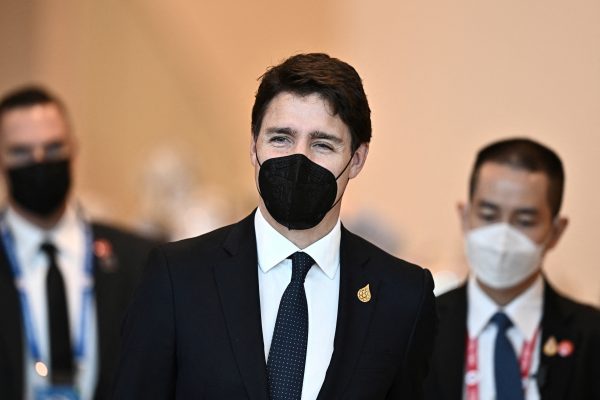The label of ‘Indo-Pacific’ is more than old wine in a new bottle. The earlier Asia Pacific idea was born in era of expansiveness, inclusive multilateralism, open regionalism, engagement with China, cooperative and comprehensive security dreams and the end of a Cold War. The Indo-Pacific era is the product of great power rivalry, securitisation of technology and trade, fragmenting globalisation, strengthened alliances, coalitions of the like-minded, a rules-based international order and an incipient Cold War.
The strategy’s commitment of C$2.3 billion (US$1.7 billion) over five years covers 27 different projects. The big ticket items are C$750 million (US$549 million) for infrastructure projects filtered through a new US-led G7 arrangement, C$550 million (US$403 million) for an enhanced military presence including a third frigate in the Indian ocean and expanded participation in regional military exercises, and C$225 million (US$165 million) for strengthening public safety and cyber security at home and in Southeast Asia.
There is also C$100 million (US$73 million) for trade promotion and diversification activities, C$100 million ($US73 million) for expanded diplomatic capacity and C$350 million (US$256 million) for a range of developmental assistance programs, people-to-people links including scholarships, network building and a new office in Southeast Asia.
Several items have a distinctive Canadian twist, including a feminist International Assistance Package, projects related to marine resource management and Team Canada trade missions.
Considering the modest budget commitment, the five-year time frame and the number of activities to be supported, the impact in the region is likely to be far from transformational. But combined with diplomatic and defence resources already in play in the region, the strategy does signal the sincerity of commitment and a long-term investment in knowledge and networks for a sustained presence.
Too brief and too replete with ambiguities and contradictory inclinations to be the final word, the strategy indicates that Canada wants to play the new regional game. This time Canada’s approach is less middle power bridge-building and more about alliances and partners that share its values.
The stark wording on China varies substantially from the engagement vocabulary of the past 50 years. Today’s China is labelled assertive and repressive, an ‘increasingly disruptive global power’ that erodes the existing rules-based international order, threatening Canadian interests and values. It highlights Beijing’s unilateral actions, foreign interference activities, coercive economic tools, arbitrary detentions and dangerous state-owned enterprises.
The strategy calls for domestic measures to strengthen cybersecurity and protect against the theft of intellectual property, and, internationally, to work more closely with the Five Eyes, NATO and international institutions to monitor and push back against Chinese assertiveness. Departing from the earlier 4C’s approach — coexistence, cooperation, competition and challenge — the new strategy claims that Ottawa will ‘compete with China when we ought and cooperate when we must’.
It builds on specific actions already taken including the Huawei 5G ban, rejection of Chinese investments in strategic minerals, the Uyghur genocide resolution in the House of Commons, public criticism of the National Security Law in Hong Kong and the recent announcement of consultations about a possible Foreign Agent Registry.
Beneath the strategy is a domestic tide of public negativity about China, unrelenting media criticism and the hardened policies of the US and other like-minded countries that have produced a new consensus in Ottawa, largely unopposed.
The strategy has elements of nuance both in what it does and does not say. It does not use the words friendshoring, decoupling or ‘genocide’. It is mute on techno-nationalism and the need for an industrial policy to counter China’s rise. There is no commitment to pursuing membership in the Quad or AUKUS.
It lauds trade diversification both ‘beyond’ and ‘within’ China even as it underlines new risks in doing business in China. It makes the case for cooperation and dialogue on existential problems like climate change, biodiversity loss, global health and nuclear proliferation. And, suggesting the cake is not entirely baked, the Foreign Minister continues to emphasise the virtues of working with China, establishing channels of dialogue and making sure existing institutions include China.
Familiar rhetoric about the growing importance of India is focused on economic and immigration issues but neither strategic nor human rights matters
Reactions so far include mainstream media support, China-hawk claims that the strategy isn’t tough enough, applause from Japan, proposals for a Canada–US Strategic Dialogue on the Indo-Pacific and Chinese taunts about a loss of Canadian independence.
Southeast Asian reactions will be especially important. The strategy emphasises ASEAN centrality and almost half of the 27 specific projects have a Southeast Asian element. In a region whose own ASEAN Outlook on the Indo-Pacific continues to promote an Asia Pacific agenda, including various forms of non-alignment, neutrality in great power conflict and opposition to the bifurcation of the global economy, Ottawa is now at odds. Whispered criticisms that Canada may not be America’s deputy sheriff in the region but is now a prominent part of the posse may become louder.
Questions abound. What will be the balance between support for ASEAN-centred inclusive institutions and coalitions among the like-minded including AUKUS, the Quad, APEC and the new US Indo-Pacific Economic Forum? What will be the balance between open trading and technology systems compared to friendshoring and supply chain resilience? Will the region take any notice?
But there is no question that amid those shifting tectonic plates — Canada is leaning closer to its American allies and away from a regional middle power role.
Paul Evans is the HSBC Chair in Asian Research in the School of Public Policy and Global Affairs at the University of British Columbia.

